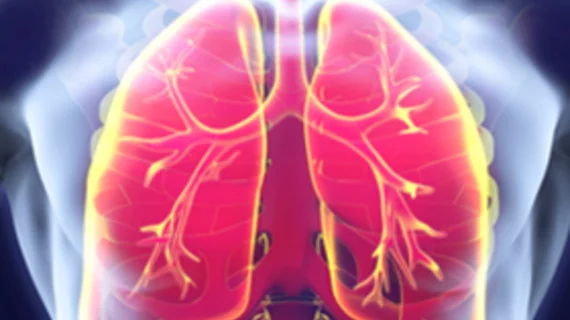CT model offers ventilation insights into ‘relatively unknown’ lung regions
A CT-based airway flow model can help clinicians study the tiny airways within the lungs, offering important information for managing chronic obstructive pulmonary disease (COPD), according to a pilot study published Oct. 15 in Radiology.
Researchers found measurements performed with their full-scale airway network (FAN) flow model, which is based on CT imaging data, compared similarly to measurements derived from functional lung imaging. In addition to improving COPD analysis, the platform can help shed light on many other forms of lung disease.
“Thoracic CT can provide valuable insight into lung structure, but the lack of functional information remains a limitation at the clinical diagnosis,” wrote Minsuok Kim, with Oxford University Hospitals NHS Trust in England, and colleagues. “The full-scale airway network flow model has the potential to provide valuable insights into regional ventilation and dynamic airflow in a variety of lung diseases.”
COPD is a leading cause of death across the globe; by 2020, experts predict it will jump to third in terms of disease mortality and fifth for disease burden, the researchers wrote. Imaging techniques such as hyperpolarized gas MRI (29Xe MRI) and technetium 99m–diethylenetriaminepentaacetic acid aerosol SPECT ventilation imaging (V-SPECT) are effective, but limited by availability and cost.
Kim and colleagues used the FAN flow model to determine pulmonary ventilation in nine participants with COPD between May and August 2017. Those models were compared to functional imaging data taken with 29Xe MRI and V-SPECT.
Overall, ventilation models created using FAN flow showed “strong positive correlation” with images gather from 29Xe MRI and V-SPECT.
“This is the first study, to our knowledge, to demonstrate successful full-scale assessment of pulmonary ventilation distribution by using a network airway flow model that correlates with functional imaging,” the researchers explained.
In a related editorial, Mark L. Schiebler, MD, with the University of Wisconsin School of Medicine and Public Health, and Grace Parraga, PhD, of Western University, London, Canada, said studying this “relatively unknown region of the body is exciting,” and argued Kim et al.’s research will likely apply to areas outside of academia.
For example, researchers could learn how to prevent air pollution, cannabis and tobacco smoke, or vapor products from harming the lungs. The FAN model, they noted, could even offer insights into how our lungs age.
“Knowing what happens to the airways will allow investigators to research methods that can act to keep the lungs youthful,” the pair explained. “We look forward to future innovations on the basis of modeling of the small airways.”

